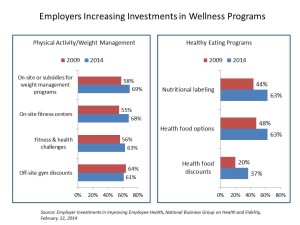
Employers continue to invest in wellness programs aimed at improving employees’ health. In 2014, 3 in 4 employers plan to offer incentives to employees who participate in health improvement programs compared = and the financial value of these incentives has grown to $500, up from $338 in 2010.
In its fifth year, the National Business Group on Health (NBGH)/Fidelity Investments have conducted their benefit consulting survey, culminating in the report, Employer Investments in Improving Employee Health.
In the past 5 years, employers have increased their investments in wellness: the chart illustrates the growth of programs addressing physical activity/weight management and health eating, both of which are gaining companies’ investments. Dollar investments in healthy eating programs, in particular, have seen double-digit growth since 2009 (the first year this survey was conducted). About two-thirds of employers have increased spending on nutritional labeling and health food options, in particular. One-third of employers are investing in healthy food discounts in 2014.
Onsite fitness centers have grown while discounts/subsidies to offsite gyms are receding in popularity among employers. Health challenges, too, are gaining traction with employers: two-thirds of employers in this survey used health challenges in 2013, most commonly for physical activity (94%), weight loss (68%), and to support individual health goals (32%).
The most popular health management programs in 2014 are:
- Employee Assistance Programs (EAPs), with 97% of employers funding these
- On-site flu shots, 94%
- Smoking cessation, 93%, growing 27 percentage points since 2009
- Health fairs, lunch and learns, at 90%, also fast-growing since 2009 by 20 percentage points
- Nurseline, 87%, increasing by 8 percentage points
- Preventive care reminders, 77%, growing 9 percentage points
- Second opinion service, 49%, growing 9 percentage points
- On-site medical/health clinic, 43%, growing 11 percentage points.
The biggest single incentives are offered for smoking cessation, on average $280, followed by disease/care management programs and biometric screenings, both incentivized at $200 on average. Incentives for physical activity programs are worth $150 to employees, and health risk appraisals (HRAs), $130.
Weight management program participants receive, on average, a $100 incentive.
Financial incentives for participating in wellness programs are delivered through several methods: via cash or gift cards, employee benefit contribution, or contribution to a health savings plan (HRA, HSA, or FSA).
Over one-half of employers are tracking the following biometrics, for incentives: weight/BMI, cholesterol, and fasting glucose. Another 43% of employers track waist circumference (as a function of weight management), 26% monitor HbA1C, and 19% track blood pressure.
Looking forward, 44% of employers believe they’ll continue or increase investments in wellness, whether they migrate health benefits to private exchanges or keep their traditional role in health plan sponsorship.
The survey was conducted online between November-December 2013 among 151 companies who were members of NBGH or clients of Fidelity Investments.
Health Populi’s Hot Points: Non-communicable diseases — heart diseases, diabetes, some cancers, among other conditions — are largely amenable by changing four behaviors: quitting smoking, making good food choices and portion control, moving around more, and reducing excessive alcohol drinking. More employers understand this, and their growing investments in employee wellness focusing on behavior change are laudable.
There’s an artifact in this survey that’s especially worth digging into regarding healthy eating and connecting that dot to weight management and physical activity. There is growing interest, shown in this poll, among employers incentivizing health eating among employees in the form of nutritious food discounts: THINK employer-based Groupon for healthy food shopping leading to healthier eating behavior. That’s a good thing.
Since the launch of HealthcareDIY in October 2013, we’ve learned about consumers’ passion for talking and learning about food, nutrition and health. We purposefully launched one week after the Health Insurance Exchanges went live on 1 October to be a source of support for people seeking to know more about health plans, health financial literacy (like “what the heck’s an HSA or a high-deductible?”). That support falls into our “Shop Smart” pillar. But we quickly saw that the “Eat Right” tab of information, tools, and blogs got many more hits and attention than peoples’ interest in learning about health insurance shopping.
Employers can learn from our experience by further bolstering the food-health connection. People are keen to project-manage health with food, and grocery retailers are at-the-ready to help consumers spend their hard-won dollars in search of healthier fare. Witness the growth of gluten-free and ethnic food aisles. See the expanding hiring among grocers of nutritionists who help shoppers build healthy lists for managing this week’s menu for a diabetic in the family, or a child with a GI issue.
Food = health, and employers can be an integral part of that growing health ecosystem. Watch for Zipongo, among other start-ups, to fill this niche.




 Thank you FeedSpot for
Thank you FeedSpot for